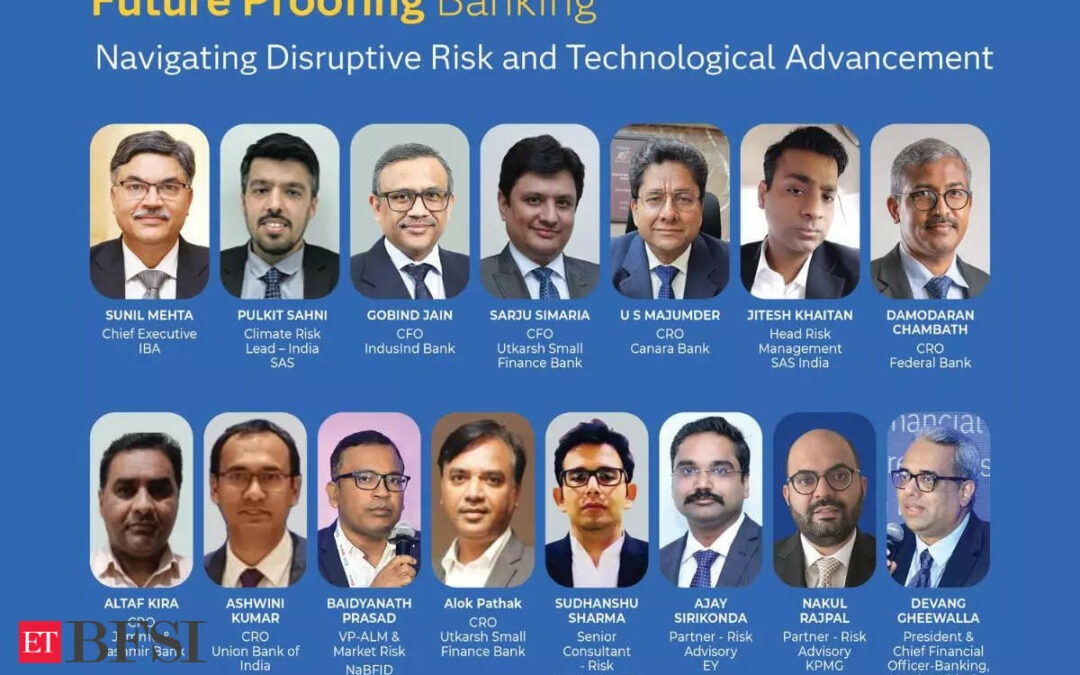The shift has been so significant that the Chief Financial Officer of a leading bank believes that IFRS 9 has completely changed financial reporting and accounting. Notably, the RBI has also significantly strengthened its regulations and supervision of banks and other regulated entities in recent years. However, the unprecedented level of accessibility and technological advancement also brings its fair share of challenges. The question arises – Are BFSI players ready to meet these growing complexities?
In response to this pressing need, ETBFSI, in collaboration with SAS, a leader in data and analytics, organized a summit titled “Future Proofing Banking: Navigating Disruptive Risk and Technological Advancement.” This summit brought together financial leaders and senior banking experts from across India to collectively address these challenges and chart a path forward.
Engaged in dynamic discussions, attendees gained insights on pivotal topics including the implementation of IFRS 9, combating money laundering, and managing interest rate risk in banking books (IRRB). In his keynote address, Sunil Mehta, the Chief Executive of IBA offered valuable perspectives on industry trends, emphasizing the transformative impact of technology on banking operations.
“From traditional banking models to the era of digital payments, India has emerged as a global leader, fuelled by innovative solutions and banking ecosystem support,” Mehta said.
“The digital transformation is bringing newer expectations among millennials, as well as existing customers. Disruption is not a one-time event but happens on a day-to-day basis. By using data mining techniques, machine learning, and AI, we can now analyse consumer behaviour,” he shared. “Although the entire ecosystem for creating NPCI and the payments system was with the banks, with the disruptions made by fintech’s and big-tech’s, 60 to 70% of the ecosystem is now in their hands.”
The sessions at the summit delved into critical aspects of that are set to impact the future of banking, ranging from regulatory compliance to strategies that leverage cutting-edge technologies. The agenda highlighted the imperative transition to IFRS 9, combating money laundering, managing interest rate risk in banking books (IRRB), efficient credit risk analysis and accounting, and reducing the time and cost of compliance, among other topics.
Green Frontier: Climate Risk in Banking
Attendees heard from Pulkit Sahni, Climate Risk Lead-India, SAS, as he shed light on the climate risks facing the sector. He said, “Emerging and developing economies are most vulnerable in terms of technological capabilities and access to finance for adaptation and mitigation. Amid scientific reinforcement of the severity of climate change, the potential disruption and implication on the finance sector have come to the forefront.”
Sahni also highlighted how India has been vulnerable to the climate change catastrophe altogether. “Sectors such as coal and steel are likely to face serious disruptions with renewables, carbon capture, and adaptation technology likely to benefit.”. He emphasized how such changes are likely to impact the balance sheets of financial institutions. Sahni further shared how climate risk can translate to core financial concerns, encompassing credit, market, liquidity, and operational risks. Talking about the perception of climate risk in the field of Indian banking, he said almost 90% of respondents consider climate risk a material threat, while 80% noted that their boards had discussed climate risk in the recent financial year.
IFRS 9: Transforming Financial Reporting and Credit Risk Management in Banks
This panel discussion delved into the intricacies of IFRS 9 implementation, with industry experts offering nuanced perspectives. Gobind Jain, CFO, IndusInd Bank, stressed that IFRS 9 has completely changed financial reporting and accounting. “It’s no longer the duty of only the CFO; you must involve the risk team as well. You must make a business model assessment. A lot of disclosures need to be put in place. Also, Expected Credit Loss (ECL) is very difficult to implement as it requires a lot of data. There are data gaps and inadequacies,” Jain further stated.
U.S. Mazumder, Chief Risk Officer, Canara Bank, said, “Accounting language will be the same globally with IFRS 9 in force. Whenever we are going to raise money from abroad, we need to reinstate our balance sheet. It will also help in increasing the recovery percentage and pulling down the NPA level.” Addressing challenges, he said one of the hurdles will be communicating with stakeholders. He highlighted that an additional hurdle for a public sector bank is the shift from a rule-based regime to a principle-based one.
Sarju Simaria, CFO, Utkarsh Small Finance Bank, highlighted the perspective of small finance banks and said, “In our case, we are very clear about the potential of IFRS 9 being mandated. When you are into ECL as a small finance bank, one of the ways to handle it is to create a floating provision and not wait for the actual change to happen.”
Sharing his experience, Devang Gheewalla, CFO, Kotak Mahindra Bank, echoed Mazumder’s sentiments, stressing the strategic importance of ECL in assessing credit quality. “Don’t look at this as purely a finance or accounting project. ECL gives us far more clarity on the credit quality of our portfolio. A holistic approach and governance towards implementing this project is important.”
Ajay Sirikonda, Partner, Risk Advisory, EY, talked about the transition of entities towards IFRS 9 and said there is a need for stakeholders to be a part of it. “It’s not just a CFO or CRO problem. You also need voices from the business to understand the numbers. ECL numbers are going to hit your credit cost directly. Once you start putting that into your performance measurement, a lot of questions are going to arise. Also, advisory on how to improve the credit cost is crucial,” Sirikonda added.
Jitesh Khaitan, Head Risk Management, SAS, highlighted the strategic implications of IFRS 9 implementation, emphasizing the need for transparency and data integrity. “As banks embrace IFRS 9, meticulous data management and stakeholder engagement are pivotal to navigating scrutiny and optimizing credit cost,” Khaitan said.
Next Gen ALM: Navigating Interest Rate Risk in Banking Book
The summit also featured an interesting discussion where experts delved into the challenges and opportunities presented by IRRB reporting. Ashwini Kumar, Chief Risk Officer, Union Bank of India, pointed out the benefits of IRRB reporting, noting its comparative advantages over previous models. “IRRB reporting marks a significant improvement in risk management tools for banks. However, there remains room for enhancement, particularly in accessing historical data,” Kumar said.
Altaf Kira, Chief Risk Officer, Jammu & Kashmir Bank, emphasized banks’ pivotal role in technological advancements and the challenges posed by model formation in the face of evolving interest rates. “As technological advancements revolutionize banking operations, banks must grapple with the complexities of model formation and interest rate fluctuations.”
On similar lines, the Chief Risk Officer of Federal Bank, Damodaran Chambath, elaborated on the concurrent challenges posed by IFRS and IRRB guidelines, particularly in the context of escalating interest rates. “The evolving regulatory landscape presents formidable challenges for banks, from data management to system upgrades. However, adaptive strategies and innovative solutions will enable banks to navigate these challenges effectively,” Chambath added.
Bringing to the forefront the IRRB applicability to small finance banks, Alok Pathak, Chief Risk Officer, Utkarsh Small Finance Bank, emphasized its potential as a risk management opportunity. He said that while IRRB may not apply to small finance banks, it presents a significant opportunity for risk management. By leveraging supportive assumptions and behavioural analysis models, banks can enhance their risk management practices and capitalize on business opportunities.
Baidyanath Prasad, Vice President & Head Market Risk and ALM at NaBFID, shed light on the challenges encountered in loan sanctioning and interest rate management. He said, “A significant challenge arose from sanctioning loans based on floating rates, resulting in substantial interest rate exposure. Despite being in a nascent stage regarding interest rate management, we have proactively hedged our positions in the derivative market—a practice uncommon in many banks.”
Furthermore, Nakul Rajpal, Partner, Risk Advisory, KPMG, also discussed the critical aspect of modelling when addressing IRRB challenges and said, “Banks are intensively focusing on modelling to address the mismatch between floating rates and Casa and term deposits, especially during periods of stress. Both IFRS and IRRB demand a macroeconomic overlay and cashflow-based analysis, necessitating meticulous work in the data framework,”
Summary:
The summit had speakers and attendees deliberate on strategies to move beyond mere transactions, aiming to establish ethical and resilient foundations for an interconnected, secure, and socially responsible banking future.
It explored the multifaceted landscape of risks and opportunities – providing crucial insights into climate risk and anti-money laundering efforts, acknowledging the imperative for banks to reassess their risk management frameworks in the face of evolving environmental and regulatory landscapes.
(Disclaimer: The above content is non-editorial, and TIL hereby disclaims any and all warranties, expressed or implied, relating to it. This is a Brand Connect Initiative.)










